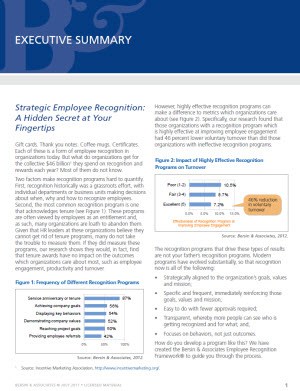New Recognition Research: A Hidden Secret to Talent Management
I’m excited to announce that this week we launched our Employee Recognition research, a program we started early last year.
 As I’m sure you know, organizations around the world are suffering from low levels of employee engagement for many reasons. The unemployment rate is high, people are working harder than ever, and employees are overwhelmed with too much information and technology at work.
As I’m sure you know, organizations around the world are suffering from low levels of employee engagement for many reasons. The unemployment rate is high, people are working harder than ever, and employees are overwhelmed with too much information and technology at work.
In addition, the workplace has rapidly become younger and more global, forcing business leaders to think hard about how to create multi-cultural teams that work well with each other, share skills, and stay focused on the business while the economy goes through rapid change.
Well over the years we’ve studied many elements of talent management (leadership development, goal-setting, performance appraisal, knowledge sharing, onboarding, etc.) and shown our members, through our maturity models, that many of these “soft” topics have become hard. And study after study (The Lloyds of London study is the most compelling in my book) shows that CEO’s are worried about the skills and capabilities of their teams above nearly everything else.
So in our ongoing quest to find ways to help businesses improve performance, we looked at another important HR practice: employee recognition.
The Employee Recognition Industry
It turns out that the employee recognition industry is old and largely dominated by companies that sell gifts, rewards, and incentive programs. We estimate that the recognition market is over $45 billion in size (World at Work estimates that 2% of payroll goes into recognition!), and is mostly focused on rewarding tenure.
Yes, tenure. 87% of companies have some type of tenure-based reward program. That means you get rewarded for “sticking around.” Our research found that these programs drive very little value at all, and in fact only 58% of the employees we surveyed even know that their company has such a program.
So when we looked at this space we took a new approach. We looked at how recognition could be integrated with talent management and what role it may play as a business performance tool. We did this by assessing many elements of recognition and looking at the correlation between a “recognition-rich culture” and various types of business outcomes (voluntary turnover being one of the biggest).
What we Found
In brief, what we found was that companies with a “recognition-rich culture” vastly outperform others. (And only 17% of the respondents fit into this category.) In particular, the top 20% of these companies have a 31% lower voluntary turnover rate, which is a huge measure of performance. Most CEO’s would spend millions of dollars to stop voluntary turnover (ie. good people leaving).
We also found that there were some key best-practices which drive this culture, and these include creating a strong peer-to-peer recognition program, focusing recognition on corporate goals and behaviors, story-telling, and giving recognition frequently and openly.
It turns out that leadership-led recognition is important, but far less important than HR managers believe. While we obviously want leaders to appreciate people at work, they are often unaware of the heroes in the organization so they are unable to drive a culture of recognition unless the program is “social” and peer-based as well.
My conclusion is that this whole area needs to be moved from compensation and benefits and reorganized into the talent management team. We are including our recognition tools and research in our Performance Management framework, because the real goal here is to use Maslow’s Hierarchy of needs to help drive individual and team performance. When you recognize the right things in the right way, people work harder, they have more fun at work, and they deliver greater levels of customer service.
Watch for our webinars on this topic, and I encourage you to join our membership to gain access to this valuable new set of tools and information.
The 100-year old rewards industry is going through a lot of change and now is the time for you, as an organization, to take advantage of these new practices to drive a performance-driven culture of recognition in your company.



Great one and I can confirm that exactly what my organisation has done. engagement eg. Recognition and rewards now within talent mangement remit across 22 countries in Africa, Midde east and Asia